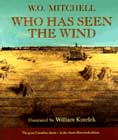 |
Canadian Authors - General fiction - |
|||||||||||||||||||||||||||||||||||||||
|
||||||||||||||||||||||||||||||||||||||||
|
Who Has Seen the Wind |
||||||||||||||||||||||||||||||||||||||||
 Who Has Seen the Wind by Who Has Seen the Wind byW. O. Mitchell McClelland & Stewart Inc. 352 Pages, 1998 ISBN: 077106098X Reviewed by Zaheera Jiwaji Read our author profile and reviews of his other works W. O Mitchell ranks among the most beloved early Canadian writers who helped to establish Canadian literary geography. Just as Margaret Laurence entrenched Neepawa, Manitoba in our minds, and Ethel Wilson captured the beauty of the British Columbia landscape, Mitchell portrayed the beauty and power of the Canadian prairies. In 1947, he gained fame with his very successful first novel Who Has Seen The Wind, now a Canadian classic. It introduced the theme of mortality, which pervaded Mitchell's writing career. The novel suggests echoes of the author’s own life. It is the coming of age of Brian O'Connal, a young boy growing up in a small Saskatchewan town during the Depression. Although a limited world, the town of Arcola represents Brian's initiation to a greater and more mature understanding of life, death, and spirituality. Along with eccentric yet compassionate characters such as the town drunk, the doctor, the schoolteacher and the principal, several events teach Brian about justice and about valuing all life equally. This includes the life of those who are shunned by society, as well as the life of animals, and the force of nature. The story moves through Brian’s early years to the pivotal event of his father’s death. Through vividly written passages, Mitchell articulates this young boy's encounter with the spirit of God, his confusion about death, and his grief. The ever-present prairie wind, causing the dry and harsh years of Depression, is transformed into a benevolent and comforting presence. For Brian, the wind is the essence of God. In Who Has Seen The Wind, Mitchell effectively gives voice to the larger questions of life in the adult world, seen through the eyes of a young boy. Young or old, readers will be drawn into Brian's colourful world. Imaginatively told, these passages endure long after the book ends. This is W.O Mitchell at his best. |
||||||||||||||||||||||||||||||||||||||||
|
|
||||||||||||||||||||||||||||||||||||||||